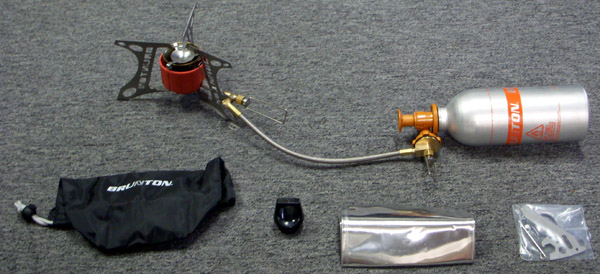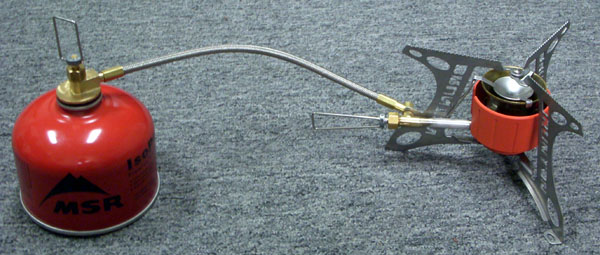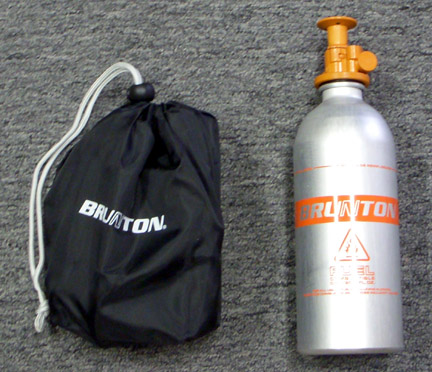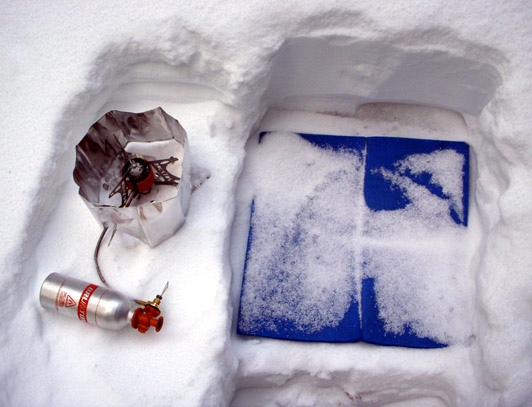Product Description
The Brunton Vapor-AF is noted by the manufacturer as being an all-fuel expedition stove. This is a multi-fuel stove that can not only burn many types of fuel but can do it with just a single jet. This eliminates the scenario of possibly needing to change the jet in the field due to being forced to change fuel type. It can not only burn all the liquids normally associated with a two-jet multi-fuel like my old backpacking stove, but it can also burn butane and every type of liquid fuel (white gas, kerosene, diesel #1, auto fuel, jet fuel, and others) and, with a twist of the body it will even burn from butane (mixed gas, isobutane / propane) canisters found in many outdoors stores.

Components of the stove with the Vapor AF attached to the bottle and pump.
It came with everything seen above: the stove, an empty liquid fuel bottle with stopper cap, folded aluminum windscreen, and a black nylon stuff sack. A plastic bag contained a jet cleaning needle, spare O-rings and a maintenance tool that besides having everything needed to work on the stove, has a bottle opener. I am sure my husband will like that. The fuel bottle reminds me of the Sigg aluminum bottles I have seen in retail stores.
This stove has three angled steel leg / pot supports. The legs swing around the burner from the folded position to make the base for the stove and the pot support. They have a saw-tooth pattern on the top to keep pots from sliding around. They also have the Brunton name cut out of them along with a few oblongs to cut weight.
The stove is made up of an orange aluminum burner cup with a brass inner burner cup nested inside of it. A steel flame spreader cup sits on top of the inner cup. It will fall off if not kept in place with a wire keeper that is attached to one of the legs. A control valve comes from the bottom of the inner burner. A folding wire handle at the end of it controls the flame. By holding the burner cup and moving the control valve stem either left or right changes the stove from butane (right) to liquid (left). It is marked "G" or "L" to indicate the gas or liquid setting. Coming from the side of the control valve is the braided steel fuel hose. At the end of this hose is the canister valve with another folding wire handle.
An orange plastic pump fits into the bottle for use with liquid fuels. It screws onto the canister valve and is placed with the word "on" facing up. To burn liquid fuel the pump is worked about 20 times to pressurize the bottle. A little fuel is allowed to go into the priming wick and then lit on fire. After the flame gets small the control valve is opened up and the warm vaporized fuel burns normally. When finished using the stove the bottle is flipped while still burning over so that the side marked "off" is now facing up. This puts the fuel pick-up pipe at the top of the bottle now letting it draw air in and push the left over fuel out where it burns off. This keeps it from spewing fuel when I am done with it.
To burn gas the canister valve is screwed onto a butane/propane mixed fuel canister. The canister valve is opened and then the fuel control valve is slightly opened until the hiss of escaping gas is heard. A touch of a match to the burner and the stove is going. When finished a twist of the valves turns the stove off and the canister may be removed.

Stove in canister mode.
Brunton recommends using the included jet cleaning needle before each use to keep from have problems from dirty fuel or junk introduced from outside.

Vapor-AF stove and all parts packed in the storage sack next to the bottle.
There was an instruction manual included in the packaging, but I am moving and I somehow misplaced it. I went to the manufacturer website to see if I could find the operating instructions on the Vapor-AF stove. I easily navigated through the website to find the information that I was looking for. I downloaded the PDF file of the instructional manual. There are safety warnings, fuel types, operating instructions, cleaning instructions, and a parts list on the two page file. The website listed the stove specifications, and a picture of the Vapor-AF stove. The website picture does the actual stove no justice. I am very impressed with the looks of the stove and the craftsmanship. The Vapor-AF appears very durable and rugged. I did not get this impression from the website.
|
Field Report
April 1, 2008 |
Testing Locations
During the past two months the Brunton Vapor-AF stove was used on two overnight trips in the following locations:
San Jacinto State Park, California: The elevation at Round Valley was 9,100 ft (2,774 m). There was snow on the ground with clear skies and no precipitation. The temperatures were 33 F (1 C) for a high and low of 19 F (-7 C). Base snow: over 3 ft (0.91 m).
San Jacinto State Park, California: I went back to this area for another night of backpacking. There was still snow on the ground. We camped at 9,100 ft (2,774 m) and the temperatures were a mild 50 F (10 C) for a high and 25 F (-4 C) for the low. Base snow: 2 ft (0.61 m) and less. |
|
Performance in the Field
During the past two months the stove has been used on two one-night backpacking trips. On each trip it was used to make breakfast, hot apple cider after setting up camp, and dinners. The first trip entailed using the fuel bottle with white gas for fuel and on the second trip I used a canister. I found that using the stove is pretty straightforward. I just had to make sure the control valve stem on the burner cup was moved to the correct setting for the fuel I wanted to burn. I had no issues with keeping the stove lit during the testing period. There was no need for me to melt snow on either trip because there was water near by.
During the first backpacking trip the Vapor-AF stove was used with white gas fuel. The flame spreader cup was not attached and was inside the stuff sack. This was because the wire keeper became dislodged and was no longer holding it in place. After fiddling with it I got it back into place. Placing the flame spreader cup correctly can be tedious and I was not successful with gloves on.
I pumped the liquid fuel bottle about 20 times to pressurize it for cooking. I screwed the bottle's canister-type valve and placed it with the word "on" facing up. I turned on the fuel control valve and turned the small control valve closest to the stove on for a few seconds. After turning off the small control valve I lit the stove with a match at the base of the orange burner cup. After about a minute the flame began to get small and I opened up the small control valve. For the meals on this trip I used my Snow Peak cookset and boiled 16 oz (0.47 L) of water each time. When I was finished boiling the water I flipped the fuel bottle to the off position. I was surprised to see how long it took the fuel to burn out of the line. I waited two minutes before turning the stove on high flame to remove all the fuel.
On the second trip I set the stove up to use the canister fuel method. I used a Snow Peak brand butane/propane mixed fuel canister. I could not find any of the Primus canisters in my local retail stores. I am also new to the California area so I may have looked in the wrong places. But, my husband did tell me he has two of the large size. The legs were easily placed into the proper position and snapped into place. Again I had to fiddle with the flame spreader cup and fasten it to the wire keeper. This seems to become dislodged when stored in the stuff sack. So after finally attaching the flame spreader cup I was ready to attach the canister. I held the burner cup and moved the control valve stem to the setting marked "G" for gas. I attached the canister to the end of the fuel hose by screwing the canister valve to the top of the canister. I turned the canister valve on and ignited the stove at the top with a match. On this trip I cooked two meals inside the vestibule of the tent so no windscreen was necessary. I used a titanium pot to cook the meals and boil water in. I was able to simmer my food by turning the control valve. I was very surprised how the flame was steady and not spurting. Plus I was able to get the flame exactly the way I needed it to simmer my food.
When packing the stove up for storage I found that it is best to wait until the stove is completely cool. The bottoms of the legs/pot supports are cool to the touch immediately after cooking. However, the orange burner cup and the upper half of the leg/pot supports are extremely hot and does take some time to cool. I picked up the stove and started to collapse the legs while the burner cup was still hot. Ouch!
I would like to see an igniter included with this stove. I think that would be a nice addition to this stove. I determined this after using several matches to light the stove. Some of my matches were faulty and sometimes I was too slow trying to ignite the stove.
I really like the canister attachment and the fact that the same attachment works for the fuel bottle. The fuel bottle "on" and "off" feature is great for getting all the fuel out of the line.
I performed a boil timed test at 101 ft (31 m) above sea level using the canister, white gas fuel and a 1.5 L (51 fl oz) titanium pot. The amount of water tested was 1 L (34 fl oz). The first test was with the canister fuel, at 3:25 bubbles were released and at 7:37 the water was at its maximum boil. The second test was with white gas, at 3:08 bubbles were released and at 6:47 the maximum boiling point was reached. I also tested how long it would take the fuel to empty out of the fuel line with the bottle in the off position with a high flame. The line was emptied at 1:51.
Brunton customer service is great. I had an issue with the fuel bottle and the pump that would not be generally covered under a warranty. But, they covered it and sent me out a new one very quickly.
Long Term Report
June 1, 2008 |
Testing Locations
During the past two months the Brunton Vapor-AF stove was used on four camping/backpacking trips in the following locations:
Joshua Tree National Park, California: The low temperature was 51 F (11 C) with highs around 72 F (22 C). The stove was used in the National Park Campground during a group rock climbing trip. The elevation was approximately 4,200 ft (1,280 m). This was a two day camping trip.
San Jacinto State Park, California: Camp was set up at Lower Chinquapin located at 9,000 ft (2,743 m). The low was 38 F (3 C) and the high was 54 F (12 C). There were some wind gusts recorded at the weather station of 25 mph (40 km/h). There was still an abundance of snow in the area, trail finding was difficult.
San Jacinto State Park, California: This was a two day solo trip. Camp was set up in at approximately 9,200 ft (2,804 m). The high temperature for both days was around 58 F (14 C) and the low was recorded at 39 F (4 C).
San Jacinto State Park, California: I visited this park on a two day solo trip. Camp was set up in at approximately 9,200 ft (2,804 m) in the same location as my prior visit. The high temperature was from 40 F (4 C) to 47 F (8 C) and the low was 24 F (-4 C).
Performance in the Field
Well I must say that over the course of the four month testing period of the stove I have been very pleased with its performance.
During the past four months of testing the stove I found that it is pretty much idiot proof. I was unable to burn liquid gas on the "G" control valve stem setting and I was also unable to burn canister fuel on the "L" setting. I will admit there were a few occasions that I forgot to check the setting of the stove before trying to ignite it. If it is on the setting not for the fuel I was using it just does not work. Which I believe is a good thing.
I am still finding that after the stove is in storage or after transporting it while backpacking the flame spreader cup does not stay in place. It becomes dislodged and I have to remember to clip it back into place. While it is not dislodged every time I go to ignite the stove, it is more often than I think is necessary.
I have used various types of cooksets with the Brunton Vapor-AF stove during the testing period. On my solo trips I have used my Snow Peak cookset that has a base diameter of about 3.5 in (9 cm). On trips with more than one person I used a Evernew titanium pot that has a base diameter of just over 6 in (15 cm). The base of the larger pot is more sturdy on the pot supports. However, the pot supports are so large and have the gripping teeth on them that the smaller cookset was stable as well. I did not cook with the flame turned on high with the small cookset because the flame was being dispersed to the outside and up the sides of the cookset.
I have varied my fuel use with this stove between white gas and butane/propane mixed fuel canisters. The fuel canisters used were the 110 g (3.88 oz) and the 220 g (7.76 oz) size. There was no difference noticed in the performance of the stove by using different sized fuel canisters.
When using the stove with liquid fuels I found that priming the stove can take longer in certain weather conditions and elevation. It seemed that in colder weather the stove took longer to prime. I also found that as there became less fuel in the bottle I had to pump it more for priming.
This stove does not have a shaker jet so the stove needs to be cleaned manually. After using the stove for four months I decided to clean it. There were no performance issues and no trouble with gunk in the fuel line that I could tell. I just cleaned the stove since I was testing it and I wanted to report on cleaning the stove. In a nutshell, it is very simple to clean it. The flame spreader needs to be removed and then just stick the jet hole with the cleaning needle in the maintenance kit. The needle housing is long and I found it easy to poke into the jet hole. If the needle does not clean the jet the manufacturer notes in the directions that the stove can be cleaned by unscrewing the jet with the multipurpose wrench.
The foil windscreen provided with the stove is constructed of a heavy aluminum. It is not flimsy at all. Some effort and work is required to shape it into a circle to surround the stove. I found that the windscreen is heavy enough that small wind gusts do not blow the windscreen over.
Over time it seems that the pot support legs sometimes take a little effort to collapse. I noticed this after my last trip with the stove. This was the only time I noticed that the one pot support was stuck a little bit and would not collapse easily.
Summary
All in all I found this to be a great stove for backpacking especially for a group of people. It may be overkill on solo trips just because of the weight of the stove. However, I think it is ideal for me to take on winter solo trips when using a canister stove is not feasible. I like the versatility of being able to burn either liquid or gas fuels. The stove does an excellent job of simmering foods without a spurting flame. I still wish there was some kind of an igniter on the stove that a match did not need to be used every time. I am pretty happy with this stove and I plan on taking it on trips that I need liquid fuel or when I need to cook for a group.
Things That Rock:
- Versatility to use several types of fuel including canisters
- Not very heavy for a beefy stove
- Boils water quickly
Things That Are So So:
- The flame spreader cup slides out of place when stored
- There is no igniter
Remarks
This concludes my long term report. Thank you Brunton and backpackgeartest.org for providing me with the opportunity to test the Vapor-AF stove.
|

Winter camp kitchen
|
|




